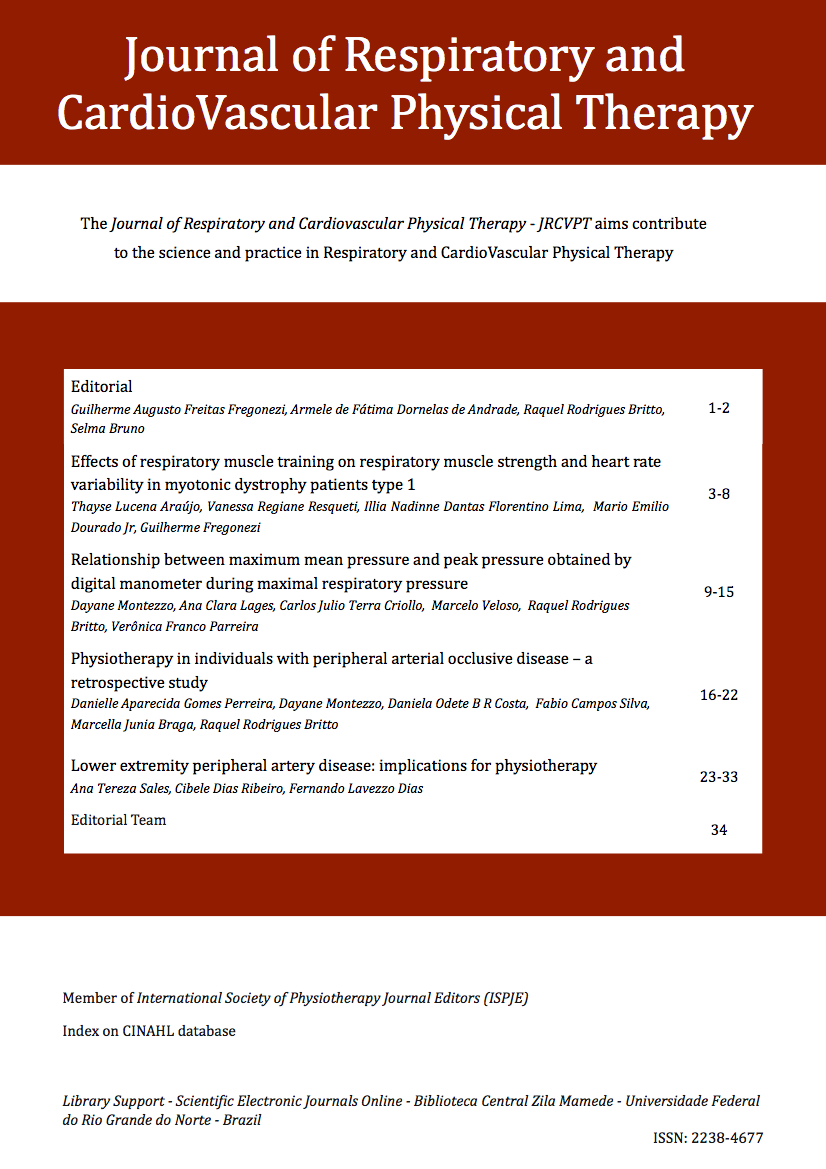Lower extremity peripheral artery disease: implications for physiotherapy
Palavras-chave:
Peripheral artery disease, physiotherapy Modalities, Diabetes ComplicationsResumo
Peripheral artery disease (PAD) is more prevalent among the elderly and is a predictor of cardiovascular mortality causing high morbidity. It is commonly associated with other illnesses such as diabetes mellitus, cerebrovascular and coronary heart disease. Even when asymptomatic, PAD patients are often treated by a physiotherapist, either specifically for lower extremity PAD or during rehabilitation for other clinical conditions, where PAD is a comorbidity. As such, physiotherapists need to better understand the clinical presentation of the disease, treatment options and precautions to be adopted when treating these patients. The objective of this brief review is to synthesize data regarding PAD epidemiology, consensus on lower extremity PAD treatment, precautions for assessing and handling PAD patients and present information on new PAD treatment options under evaluation. The supervised exercise/rehabilitation program for PAD should be the mainstay of patient treatment, owing to its clinical effectiveness demonstrated in several studies; however, there is paucity of data about long-term effects of exercise programs for PAD patients on mortality or incidence of revascularization and amputations. New PAD treatments, such as cell therapy, appear promising.
Downloads
Downloads
Publicado
Como Citar
Edição
Seção
Licença
Copyright Transfer Statement
The author(s) of the article, as specified here, hereby transfer(s) to the Revista de Fisioterapia Respirtória e CardioVascular (Journal of Respiratory and CardioVascular Physical Therapy) all copyright ownership rights, title and interests that the author(s) may have or may come to have in and to the article and any revision or version thereof, including, but not limited to, exclusive right to print, publish and sell the article anywhere in the world, in any language and in any media.
This agreement will be considered effective and valid if and when the article is accepted for publication.
If the article contains any copyright-protected material from a third party, the author(s) must obtain written permission to reproduce the said material in the article from the copyright holder and send it to the Revista de Fisioterapia Respirtória e CardioVascular (Journal of Respiratory and CardioVascular Physical Therapy).
The author(s) guarantee(s) the holding of proprietary rights to the article; not having granted or transferred any rights to the article to any other persons or entity; that the article is susceptible to the demand for rights by its author(s); not having infringed upon any author rights, trademark or patent; not having violated the right to privacy or publicity of any person or entity; that the article does not contain any defaming subject; that the factual statements made are true or are based on reasonably accurate research; and, finally, that, the author(s) has/have no reason to believe that any of the formulas, procedures or prescriptions contained in the article will cause damage if used or followed in accordance with the instructions and warnings contained in the article.
The author(s) will indemnify the Revista de Fisioterapia Respirtória e CardioVascular (Journal of Respiratory and CardioVascular Physical Therapy) against any costs, expenses, damages or liability that the Revista de Fisioterapia Respirtória e CardioVascular (Journal of Respiratory and CardioVascular Physical Therapy) may incur as a result of accidental omissions of these guarantees. These representations and guarantees may be extended to a third party by the Revista de Fisioterapia Respirtória e CardioVascular (Journal of Respiratory and CardioVascular Physical Therapy).
Date:
Note: Each author must individually complete and sign this form
1) Author:
Signature: _________________________________
2) Author:
Signature: _________________________________
3) Author:
Signature: _________________________________
4) Author:
Signature: _________________________________
5) Author:
Signature: _________________________________
6) Author:
Signature: _________________________________
7) Author:
Signature: _________________________________
8) Author:
Signature: _________________________________




 English
English Español (España)
Español (España) Português (Brasil)
Português (Brasil) Français (Canada)
Français (Canada)